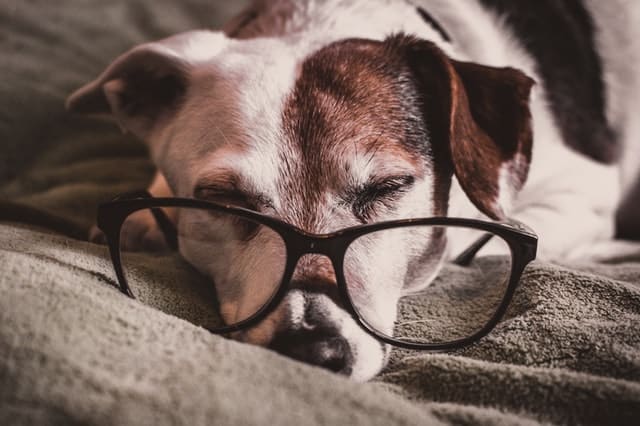
The effects of time are noticeable on both people and animals. Old age comes quickly and there are many signs, even for our animals, that indicate the arrival of the “third age”.
Your dog is getting old
The stage of aging in our animals arrives and it is necessary to take into consideration some signs that will indicate the moment in which this phase could have begun.
It is important to have some precautions to get them to arrive at this stage in the best possible way. Old age is not a disease, but the natural and progressive decay of the animal. As happens to humans, aging brings some diseases.
The two phases that indicate that the dog is aging
During the first stage, the animal begins to age on a cellular level. We will notice how its fur begins to change, becoming gray in some areas such as the legs and the muzzle, mainly due to the little movement.
In the second phase, the dog’s aging process is accelerated. He will lose his sense of smell and the hair will turn white. It will lose its luster by becoming dull, and changes in behavior will also occur.
This second phase is the most delicate, because kidney or heart disease could also occur.
Signs that the dog is aging by weight
Very small or small dogs weighing less than 5-10 kg can be considered mature when they are 7 or 8 years old, and older when they are over 12.
Dogs weighing less than 25 kg will reach mature age at 6 or 7, and seniority when they exceed 10.
Large breed dogs, between 30 and 45 kg, are considered mature over 5 years old and old when they are over 8.
Giant breed dogs, once over 5 years old, will age much faster and usually don’t get over 10 years old.
Race matters too
The breed of the dog is also another fundamental factor affecting its average age. For example, a Boxer usually lives less than a German Shepherd.
The longevity of the Dwarf Poodle is known . The longevity record is held by Bluey, an Australian shepherd dog who lived for 29 years.
The signs that the dog is aging
- The white fur. As happens to people, even in older dogs the color of the coat changes, which becomes white, especially on the muzzle.
- They do less and less physical activity. We will notice how the animal does not run or move as it once did.
- There will be movements that he will avoid making. The joints and muscles of our 4-legged friends will no longer be like those of when they were young. Because of this, certain movements such as getting on the bed may be difficult for them to perform.
- They need more rest. The dog is aging and his energy will decrease, which is why he will sleep or rest longer than before.
- Some cognitive dysfunctions. The memory will fail and they will forget where the food is and when to go to the toilet.
- They will no longer be able to hold their pee, and we may find it scattered around the house.
some more signs of ageing in dogs are:
1. It has less energy
The first change you notice in an aging dog is its energy: it no longer has the explosive and tireless vitality it had years ago.
Although dogs have always enjoyed sleeping, their naps are now longer and they prefer to do quieter activities.
Some even refuse to run after a ball, and games with other animals are calmer and less physical. They no longer appreciate adrenaline and speed, and enjoy activities and quiet walks more.
2. Mood changes
When a dog is getting older he can suffer from mood swings, which vary from case to case: some have much more patience. They tolerate puppies and young children better, and generally take things much more calmly than before.
However, some are a bit more grumpy as they don’t feel like hearing screeching noises or putting up with stressful situations.
This can also be a symptom of pain: if your dog’s temperament changes in this way, consult a veterinarian to rule out the hypothesis that he is ill.
3. The behavior of other dogs
As a dog gets older, the way his peers relate to him also changes . Dogs understand each other in a way that humans can only imagine.
Other animals feel it is getting old and what it needs.
His friends from the park will change the way you play with him, if they are less insistent on interacting or if you notice that there are fewer runs and more calm introductions each time, these are other symptoms that your dog is getting older.
An exception is puppies – younger dogs are attracted to larger ones. Provided your furry friend allows it, the little ones will try to play with him or observe him from a distance.
4. White hair and coat changes
Physical changes may also be noted as a dog is getting older. One of the most obvious concerns the hair: white hairs may appear, the coat is drier and less shiny, or has a duller color than usual. In some cases, the hair grows less or is not present in certain areas, and is rough.
It is also common for young dogs to have white hair, especially on the hips or around the mouth. However, white also reaches the eyes and ears in old age.
5. Diseases and pains appear
As a dog gets older, they are more likely to develop many types of diseases. The most frequent have to do with the eyes , joints, bones and metabolism. Weight can change too: he can lose weight or gain weight even if his diet does not change.
They can also suffer from disorientation, deafness, skin problems, allergies or digestive problems.
If your dog has to start taking pills or has to be taken to the vet frequently, it means that he is really getting old.
Tips to help your dog experience old age to the fullest
- You have to have a lot of patience with the animal. Continue with the daily walks, even if shorter and more continuous, and understand that your friend is not as energetic as before.
- His teeth should be carefully checked. In case you have lost a lot of teeth, you will need to buy food suitable for senior dogs.
- Brushing activates circulation and helps eliminate dead hair. This will help you see if there are any bumps on the skin.
- By touching their lymph nodes, you can feel if anyone has swollen, as it may be a tumor.
- In case he has long hair, cut it in the eye area, so that it does not block his view.
- Visits to the vet should be more frequent in older dogs.
The importance of medical checks
This is why it is so important that from the age of 7 all dogs have to have more frequent checks at the vet.
Only qualified personnel can identify the changes that are occurring in an animal and propose treatments to prevent or alleviate them before they affect its quality of life.






